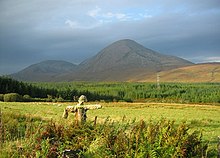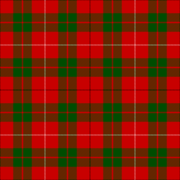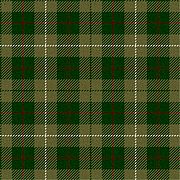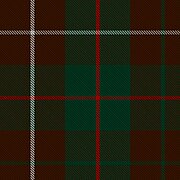Clan Mackinnon
| Clan MacKinnon | |||
|---|---|---|---|
| Clann MacFhionghain Scots Pine.[4] | |||
| Chief | |||
 | |||
| Madam Anne Gunhild MacKinnon of MacKinnon | |||
| 38th Chief of the Name and Arms of MacKinnon.[5] (Mac Fhionghain[1]) | |||
| Historic seat | Caisteal Maol | ||
| |||
| |||
| |||
| |||
Clan MacKinnon (
Popular tradition gives the clan a
Though little is known of the early history of the clan, it is likely to have served under the Lords of the Isles.
History


Myth and legend


According to legend, the castle of Dunakin (today known as
Origin of the name
The
Wars of Scottish Independence
According to the Collins Scottish Clan & Family Encyclopedia the Mackinnons gave shelter to
Origins of the clan
Little is known of the early history of the clan.
According to the historian
The earliest record of the Mackinnons is of Lachlan Makfingane, who witnessed a charter by
The chief's
Abbacy of Iona

The early clan seems to have had a close connection with the abbacy on the small
16th and 17th centuries
The Mackinnons regularly feuded with the
In 1579, Fynnoun MacKynnoun of Strathardill, and his son Lachlane Oig, were reported to
On 12 July 1606
An indication of the relative extent of the estates of the three great chiefs of Skye at the end of the 17th century is afforded by the amount of rental for each: £7,000 for Macleod, £6,200 for Macdonald and £2,400 for Mackinnon[30] (at a time when 12 Scottish pounds were approximately equivalent to one English pound sterling).
Civil War
During the
Jacobite uprisings
Although considered a relatively minor clan, it seems to have been of considerable strength.
The Mackinnon chief was later captured by Government troops and spent a year in confinement before being put on trial, with his life at stake, in Tilbury Fort.[11] Mackinnon was eventually spared his life and pardoned because of his advanced age. It is said, though, that upon leaving the courtroom the Attorney General, Sir Dudley Ryder, asked Mackinnon, "If King George were in your power, as you have been in his, what would you do?" Mackinnon replied, "I would do to him, as he has this day done to me; I would send him back to his own country".[11] Because of the chief's support of the Jacobite rebellion they lost Strathardle in 1765, and have since been held landless in their ancient clan lands.[11]
Modern history
The last chief of the senior line died unmarried in 1808; he was the great-grandson of John, elder son of Lachlan Mor who fought at the Battle of Worcester.
Chief
The current
Tartans
| Tartan image | Notes |
|---|---|
 |
Clan Mackinnon tartan as published in the Vestiarium Scoticum in 1842. Today there are many different tartans attributed to the Mackinnons. |
 |
Mackinnon Hunting tartan. This modern tartan was registered with Lyon Court in 1960, and is based upon the Mackinnon tartan found in the dubious Vestiarium Scoticum.[34]
|
 |
The MacKinnon Hunting Modern tartan Lyon Court in 1960 with a letter from 'The Mackinnon of Mackinnon', advising 'the correct setts for the Clan and Hunting Tartans of the Clan Mackinnon.'[36] (STA ref: 1641).
|
See also
Notes and references
- ^ docx). Sabhal Mòr Ostaig. Retrieved 15 October 2009.
- ^ a b c Smibert, pp. 145–147.
- ^ MacKinnon, pp. 192–195.
- ^ a b c The Highland Clans of Scotland Retrieved on 27 October 2007
- ^ a b "MACKINNON OF MACKINNON, CHIEF OF MACKINNON". Retrieved 23 October 2007.
- ^ All referred to in Downie and Mackinnon's Genealogical Account of the Family of Mackinnon (2nd edition, Edward Stanford, London, 1883).
- ^ a b c d e f g h i Skene, pp. 258–260.
- ^ Johnston, Ian. "First king of the Scots? Actually he was a Pict" Archived 24 May 2011 at the Wayback Machine. The Scotsman. 2 October 2004. Retrieved on 16 November 2007
- ^ a b c Moncreiffe, pp. 70–71.
- ^ a b c d e Gregory, pp. 80–81.
- ^ a b c d e f g h Eyre-Todd 1923.
- ^ a b c d Mackinnon Gazetteer Key Retrieved on 27 October 2007
- ^ Site Record for Skye, Goir A' Bhlair, Broadford. Royal Commission on the Ancient and Historical Monuments of Scotland.
- ^ a b Name Meanings Ancestry.com. Retrieved on 23 October 2007
- ^ a b c d e f g Byars, pp. 246–247.
- ^ Annals of the Four Masters. M964.3 Retrieved on 18 November 2007 Fínghin, angcoire & epscop Ia, d'écc.
- ^ a b c d e f Way, George and Squire, Romily. Collins Scottish Clan & Family Encyclopedia. (Foreword by The Rt Hon. The Earl of Elgin KT, Convenor, The Standing Council of Scottish Chiefs). Published in 1994. Pages 228–229.
- ^ Collectanea de Rebus Albanicis, pp. 56–67.
- ^ a b c d Collectanea de Rebus Albanicis, pp. 303–304.
- ^ Collectanea de Rebus Albanicis, pp. 296–297.
- ^ Mackinnon, pp. 192–195.
- ^ THE CLAN MACKINNON Archived 27 May 2010 at the Wayback Machine Retrieved on 27 October 2007
- ^ Allen, pp. 79–93.
- ^ Anderson, pp. 28–29.
- ^ a b c d e f g h i j k l Maclauchlan & Wilson & Keltie, pp. 256–258.
- ^ a b c A Description of the Western Isles of Scotland Called Hybrides, by Sir Donald Monro Retrieved on 23 October 2007
- ^ a b c W & A K Johnston, p. 60.
- ^ a b Gregory, pp. 285–286.
- ^ Collectanea de Rebus Albanicis, p. 119.
- ^ Alexander Nicolson, History of Skye (3rd edition, Islands Book Trust, 2012), at page 128.
- ^ Titles of Nobility Retrieved on 27 October 2007
- ^ Allardyce, p. 169.
- ^ Over 150 male clan members from Skye presented a "humble address" to Corriechatachan in 1848.
- ^ Mackinnon Hunting Clan Tartan WR917 Retrieved on 20 November 2007
- ^ Mackinnon Tartans Retrieved on 11 May 2023
- ^ Tartan Details - MacKinnon Hunting #3 Retrieved on 11 May 2023
Bibliography
- The Scottish Clans and Their Tartans, With Notes, Library Edition. W. & A. K. Johnston, Ltd.
- Allardyce, James (ed). Historical Papers Relating to the Jacobite Period, 1699–1750. Aberdeen, 1895–96.
- Anderson, William. The Scottish Nation. vol 3. Edinburgh & London: A. Fullarton & Co., 1863.
- Downie, Sir Alexander Mackenzie and Mackinnon, Alister Downie. Genealogical Account of the Family of Mackinnon, compiled many years ago from authentic records. 2nd edition, Edward Stanford, London, 1883.
- Eyre-Todd, George (1923). The Highland Clans of Scotland: Their History and Traditions. Vol. 2. Heath, Cranton / Appleton. pp. 116–123 ("328–333").
- Gregory, Donald. History of the Western Highlands And Isles of Scotland, From A.D. 1493 To A.D. 1625. Edinburgh: William Tait, 1836.
- Mackinnon, Charles. Scottish Highlanders. Barnes & Noble Publishing, 1995. ISBN 0-88029-950-9.
- Maclauchlan, Thomas & Wilson, John & Keltie, John Scott. A History of the Scottish Highlands, Highland Clans and Highland Regiments. Edinburgh and London: A. Fullarton & Co., 1875.
- Moncreiffe of that Ilk, Sir Iain. The Highland Clans. London: Barrie & Rockliff, 1967.
- The Iona Club (ed). Collectanea de Rebus Albanicis. Edinburgh: Thomas G. Stevenson, 1847.
- J. Romilly Allen. "The Early Christian Monuments of Iona". Proceedings of the Society of Antiquaries of Scotland. vol. 35, pp. 79–93. 1900–01.
- Skene, William Forbes. The Highlanders of Scotland, Their Origin, History, And Antiquities. London: John Murray, 1837.
- Smibert, Thomas. The Clans of the Highlands of Scotland. Edinburgh: James Hogg. 1850.
External links
![]() Media related to Clan Mackinnon at Wikimedia Commons
Media related to Clan Mackinnon at Wikimedia Commons
